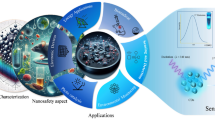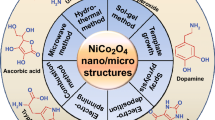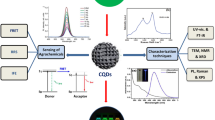Abstract
A microwave-assisted hydrothermal route was employed to prepare fluorescent tannic acid (TA)-derivatized graphitic carbon nitride quantum dots. The resulting dots display blue fluorescence (best measured at excitation/emission wavelengths of 350/452 nm) with a quantum yield as high as ~44%. The incorporated TA imparts a fluorescence switching behavior in that very low concentrations of Cu(II) can quench the fluorescence, while (AA) can restore it. It is presumed that AA causes Cu(II) to be transformed to Cu(I). Based on these findings, a fluorometric method was designed for AA detection. The probe allows AA to be detected with a 50 pM limit of detection and a linear analytical range that extends from 0.1 to 200 nM of AA. Real and spiked samples were successfully assayed by the probe to demonstrate its analytical applicability.

Schematic presentation of fluorescent graphitic carbon nitride quantum dots functionalized with tannic acid. Their fluorescence is quenched by Cu2+ and recovered by ascorbic acid (AA). This is exploited in an assay with a picomolar detection limit.







Similar content being viewed by others
References
Groenewolt M, Antonietti M (2005) Synthesis of gC3N4 nanoparticles in mesoporous silica host matrices. Adv Mater 17:1789–1792
Barman S, Sadhukhan M (2012) Facile bulk production of highly blue fluorescent graphitic carbon nitride quantum dots and their application as highly selective and sensitive sensors for the detection of mercuric and iodide ions in aqueous media. J Mater Chem 22:21832–21837
Achadu OJ, Nyokong T (2017) In situ one-pot synthesis of graphitic carbon nitride quantum dots and its 2, 2, 6, 6-tetramethyl (piperidin-1-yl) oxyl derivatives as fluorescent nanoprobes for ascorbic acid. Anal Chim Acta 991:113–126
Cheng Q, He Y, Ge Y, Zhou J, Song G (2018) Ultrasensitive detection of heparin by exploiting the silver nanoparticle-enhanced fluorescence of graphitic carbon nitride (g-C3N4) quantum dots. Microchim Acta 185:332–340
Wang X, Yang X, Wang N, Lv J, Wang H, Choi MMF, Bian W (2018) Graphitic carbon nitride quantum dots as an “off-on” fluorescent switch for determination of mercury(II) and sulfide. Microchim Acta 185:471–487
Li Y, Cai J, Liu F, Yu H, Lin F, Yang H, Lin Y, Li S (2018) Highly crystalline graphitic carbon nitride quantum dots as a fluorescent nanosensor for detection of Fe(III) via an inner filter effect. Microchim Acta 185:134–140
Liu S, Tian J, Wang L, Luo Y, Sun X (2012) A general strategy for the production of photoluminescent carbon nitride dots from organic amines and their application as novel peroxidase-like catalysts for colorimetric detection of H2O2 and glucose. RSC Adv 2:411–413
Achadu OJ, Revaprasadu N (2018) Microwave-assisted synthesis of thymine-functionalized graphitic carbon nitride quantum dots as fluorescent nanoprobe for mercury(II). Microchim Acta 185:461–469
Matsuoka M, Yamato M, Yamada K (2016) Fluorescence probe for the convenient and sensitive detection of ascorbic acid. J Clin Biochem Nutr 58:16–22
Shekhovtsova TN, Muginova SV, Luchinina JA, Galimova AZ (2006) Enzymatic methods in food analysis: determination of ascorbic acid. Anal Chim Acta 573:125–132
Khan A, Khan MI, Iqbal Z, Shah Y, Ahmad L, Nazir S, Watson DG, Khan JA, Nasir F, Ismail AK (2011) A new HPLC method for the simultaneous determination of ascorbic acid and aminothiols in human plasma and erythrocytes using electrochemical detection. Talanta 84:789–801
Falkova MT, Bulatov AV, Pushina MO, Ekimov AA, Alekseeva GM, Moskvina LN (2015) Multicommutated stepwise injection determination of ascorbic acid in medicinal plants and food samples by capillary zone electrophoresis ultraviolet detection. Talanta 133:82–87
Chen J, Ge J, Zhang L, Li ZH, Li JJ, Sun YJ, LB Q (2016) Reduced graphene oxide nanosheets functionalized with poly(styrene sulfonate) as a peroxidase mimetic in a colorimetric assay for ascorbic acid. Microchim Acta 183:1847–1853
Huang S, Qiu HN, Zhu FW, SY L, Xiao Q (2015) Graphene quantum dots as on-off-on fluorescent probes for chromium(VI) and ascorbic acid. Microchim Acta 182:1723–1731
Tan H, Wu J, Chen Y (2014) Terbium(III) based coordination polymer microparticles as a luminescent probe for ascorbic acid. Microchim Acta 181:1431–1437
Liu S, Pang S (2018) A dual-model strategy for fluorometric determination of ascorbic acid and of ascorbic acid oxidase activity by using DNA-templated gold-silver nanoclusters. Microchim Acta 185:426–434
Rao HB, Ge HW, ZW L, Liu W, Chen ZQ, Zhang ZY, Wang XX, Zou P, Wang YY, He H, Zeng XY (2016) Copper nanoclusters as an on-off-on fluorescent probe for ascorbic acid. Microchim Acta 183:1651–1657
Wang J, Peng X, Li D, Jiang X, Pan Z, Chen A, Huang L, Hu J (2017) Ratiometric ultrasensitive fluorometric detection of ascorbic acid using a dually emitting CdSe@SiO2@CdTe quantum dot hybrid. Microchim Acta 185:42–50
Zarei M, Ahmadzadeh H, Goharshadi EK, Farzaneh A (2015) Graphitic carbon nitride embedded hydrogels for enhanced gel electrophoresis. Anal Chim Acta 887:245–252
Lin LP, Song XH, Chen YY, Rong MC, Wang YR, Zhao L, Zhao TT, Chen X (2015) Europium-decorated graphene quantum dots as a fluorescent probe for label-free, rapid and sensitive detection of Cu2+ and L-cysteine. Anal Chim Acta 891:261–268
Cruz BH, Diaz-Cruz BM, Arino C, Esteban M (2000) Heavy metal binding by tannic acid: a voltammetric study. Electroanalysis 12:1130–1137
Wang J, Cao S, Ding Y, Ma F, Lu W, Sun M (2016) Theoretical investigations of optical origins of fluorescent graphene quantum dots. Sci Rep 6:24850
Chen S, Hao N, Jiang D, Zhang X, Zhou Z, Zhang Y, Wang K (2017) Graphitic carbon nitride quantum dots in situ coupling to Bi2MoO6 nanohybrids with enhanced charge transfer performance and photo-electrochemical detection of copper ion. J Electroanal Chem 787:66–71
Chen YJ, Yan XP (2009) Chemical redox modulation of the surface chemistry of CdTe quantum dots for probing ascorbic acid in biological fluids. Small 5:2012–2018
Wang XX, Wu P, Hou XD, Lv Y (2013) An ascorbic acid sensor based on protein modified au nanoclusters. Analyst 138:229–233
Zhang YF, Li BX, Xu CL (2010) Visual detection of ascorbic acid via alkyne-azide click reaction using gold nanoparticles as a colorimetric probe. Analyst 135:1579–1584
Lin F, Pei D, He W, Huang Z, Huang Y, Guo X (2012) Electron transfer quenching by nitroxide radicals of the fluorescence of carbon dots. J Mater Chem 22:11801–11807
Peng J, Ling J, Zhang XQ, Zhang LY, Cao QE, Ding ZT (2015) A rapid, sensitive and selective colorimetric method for detection of ascorbic acid. Sensors Actuators B Chem 221:708–716
Darabdhara G, Sharma B, Das MR, Boukherrou R, Szunerits S (2017) Cu-ag bimetallic nanoparticles on reduced graphene oxide nanosheets as peroxidase mimic for glucose and ascorbic acid detection. Sensors Actuators B 238:842–851
Wu J, Jiang K, Wang X, Wang C, Zhang C (2017) On−off−on gold nanoclusters-based near infrared fluorescent probe for recognition of cu(II) and vitamin C. Microchim Acta 184:1315–1325
Rong M, Lin L, Song X, Wang Y, Zhong Y, Yan J, Feng Y, Zeng X, Chen X (2015) Fluorescence sensing of chromium (VI) and ascorbic acid using graphitic carbon nitride nanosheets as a fluorescent “switch”. Biosens Bioelectron 68:210–217
Lakowicz JR (2009) Principles of fluorescence spectroscopy, Third edn. Springer, New York, p 243
Zou L, Gu Z, Sun M (2015) Review of the application of quantum dots in the heavy-metal detection. Toxicol Environ Chem 97:477–490
Acknowledgements
The authors wish to acknowledge funding from National Research Foundation (NRF) of South Africa through the South African Research Chair Initiative (SARCHI) in Nanotechnology. OJA thanks the National Research Foundation (NRF) for a postdoctoral fellowship and funding under SA Research Chair for Nanotechnology.
Author information
Authors and Affiliations
Corresponding authors
Ethics declarations
The authors declare that they have no conflicts of interest.
Additional information
Publisher’s Note
Springer Nature remains neutral with regard to jurisdictional claims in published maps and institutional affiliations.
Electronic supplementary material
ESM 1
(DOCX 309 kb)
Rights and permissions
About this article
Cite this article
Achadu, O.J., Revaprasadu, N. Tannic acid-derivatized graphitic carbon nitride quantum dots as an “on-off-on” fluorescent nanoprobe for ascorbic acid via copper(II) mediation. Microchim Acta 186, 87 (2019). https://doi.org/10.1007/s00604-018-3203-x
Received:
Accepted:
Published:
DOI: https://doi.org/10.1007/s00604-018-3203-x




